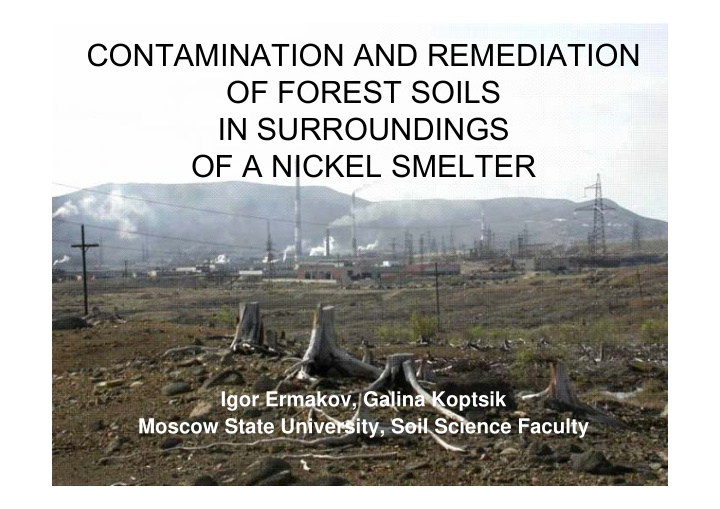



CONTAMINATION AND REMEDIATION OF FOREST SOILS IN SURROUNDINGS OF A NICKEL SMELTER Igor Ermakov, Galina Koptsik Moscow State University, Soil Science Faculty Soil Science Faculty, 08.06.2006 1 Moscow State University
Podzol soils under spruce forest and agricultural vegetation Soil Science Faculty, 08.06.2006 2 Moscow State University
Aims: • to find out the main patterns of heavy metal pollution under simulated atmospheric precipitation • to forecast natural remediation of podzol soil if atmospheric pollution would be stopped • to develop a simple and economical technology for metal in- situ removal from contaminated soils The work was supported by INTAS (01-2213) EC FP6 (INCO-CT-2005-013420) RFBR (05-04-48460- а ) Soil Science Faculty, 08.06.2006 3 Moscow State University
Scheme of column experiment Background Polluted precipitation precipitation Background Background Polluted Polluted soil soil soil soil Four types of percolates Filtration through 0.45 µm filters Analysis for pH, DOC and heavy metal concentrations Soil Science Faculty, 08.06.2006 4 Moscow State University
pH values in column percolates Background precipitation Polluted precipitation 7 7 Background soil 6 6 Background forest floor pH 5 pH 5 Polluted soil 4 4 Polluted forest floor 3 3 Precipitation 0 40 80 120 160 0 40 80 120 160 Time, days Time, days Soil Science Faculty, 08.06.2006 5 Moscow State University
Leaching of DOC under simulated precipitation (cumulative curves) Background precipitation Polluted precipitation 60 60 Background soil 50 50 Background forest DOC, g/m2 DOC, g/m2 40 40 floor 30 Background forest 30 floor (fulvic acids) 20 20 Polluted soil 10 10 Polluted forest 0 floor 0 Polluted forest 0 40 80 120 160 0 40 80 120 160 floor (fulvic acids) Time, days Time, days Soil Science Faculty, 08.06.2006 6 Moscow State University
Leaching of nickel under simulated precipitation (cumulative curves) Background precipitation Polluted precipitation 500 1000 Background 400 800 soil Ni, mg/m2 Ni, mg/m2 Background 300 600 forest floor 200 400 Polluted soil 100 200 Polluted forest floor 0 0 Precipitation 0 40 80 120 160 0 40 80 120 160 Time, days Time, days Soil Science Faculty, 08.06.2006 7 Moscow State University
Leaching of copper under simulated precipitation (cumulative curves) Background precipitation Polluted precipitation 30 800 Background 25 soil 600 Cu, mg/m2 Cu, mg/m2 20 Background forest floor 15 400 Polluted soil 10 200 5 Polluted forest floor 0 0 Precipitation 0 40 80 120 160 0 40 80 120 160 Time, days Time, days Soil Science Faculty, 08.06.2006 8 Moscow State University
Testing of different sorbents for heavy metal retention Ni adsorption isotherms Cu adsorption isotherms 450 activated 300 Cu sorbed, mmol/kg Ni sorbed, mmol/kg carbon 400 250 350 vermiculite 300 200 250 bentonite 150 200 150 100 zeolite 100 50 50 pearlite 0 0 0,0 1,0 2,0 3,0 4,0 0,0 0,5 1,0 1,5 2,0 flue ash Ni equilibrium, mmol/l Cu equilibrium, mmol/l microspheres Soil Science Faculty, 08.06.2006 9 Moscow State University
Conclusions: • Contaminated precipitation strongly acidified the mineral soil layers, and there is a real possibility for acidification of ground waters. • The background forest floor has a very high retention capacity towards both Ni and Cu. Contaminated forest floor kept almost the same buffer capacity towards Cu but strongly decreased the accumulation of Ni. • The retention of metals in the mineral layers was much less significant. Although the polluted mineral layer removed the majority of input Cu, it had a little effect on percolate Ni concentrations. Soil Science Faculty, 08.06.2006 10 Moscow State University
Conclusions: • Natural soil remediation is impossible without simultaneous contamination of ground waters. • Leaching of Ni from the soils is more rapid than that of Cu, and the risk of Ni contamination of ground waters is higher. • Leaching of Cu would be expected to take place over a longer time period, giving a consequently lower risk of groundwater pollution. • Testing of different sorbents showed that activated carbon and vermiculite can be used for Cu retention. Vermiculite also has the highest retention capacity towards Ni. Soil Science Faculty, 08.06.2006 11 Moscow State University
The 6 th Framework Programme, European Commission • CLEANSOIL - An Innovative Method for the On-Site Remediation of Polluted Soil Under Existing Infrastructures (INCO-CT-2005-013420) Soil Science Faculty, 08.06.2006 12 Moscow State University
Thank you for attention Soil Science Faculty, 08.06.2006 13 Moscow State University
Recommend
More recommend